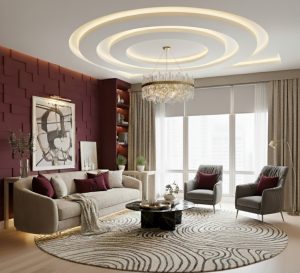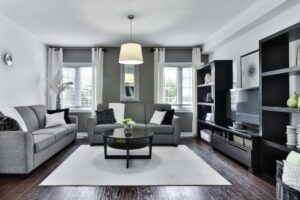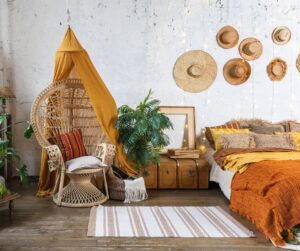Biophilic Design Dubai -Redefining Luxury Living in 2025
For decades, luxury meant marble, chrome, and that unmistakable “look at me” opulence. But something fascinating has shifted. Today’s discerning Dubai homeowners are discovering that true luxury isn’t just about what you see—it’s about how a space makes you feel. And nothing makes us feel quite as good as nature.
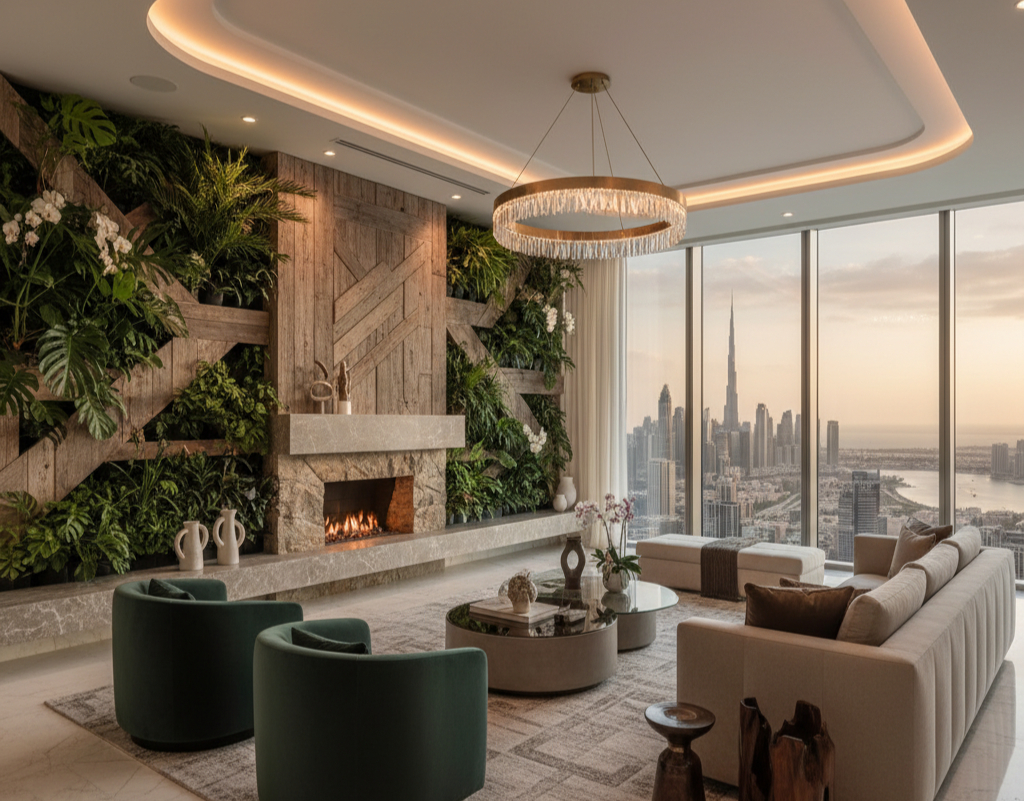
What Exactly is Biophilic Design? (And Why Dubai’s Gone Mad for It)
Let’s break it down without the design jargon. Biophilic design comes from “biophilia”, which literally means “love of life” or “love of nature.” It’s based on the rather obvious (yet often forgotten) idea that humans are hardwired to connect with the natural world. We evolved outdoors, after all, not in air-conditioned high-rises.
In practical terms, biophilic design weaves natural elements—plants, water, natural materials, organic patterns, and abundant natural light—into built environments. Research consistently shows that this approach delivers tangible benefits:
- Reduced stress levels by up to 37% in nature-rich environments
- Improved cognitive function and productivity (8-13% increase in workplace studies)
- Enhanced air quality through natural filtration
- Better sleep patterns thanks to natural light regulation
- Accelerated healing and recovery in healthcare settings
In a city like Dubai, where we spend roughly 90% of our time indoors battling the desert heat, creating these nature-rich sanctuaries isn’t just trendy. It’s essential for wellbeing.
The Science Behind the Serenity: Why Biophilic Design Actually Works
You might be thinking, “Sounds lovely, but does sticking a few plants in the corner really make that much difference?” Fair question. Here’s where the research gets interesting.
Studies published in journals like Environment International have found that participants in biophilic spaces experienced measurably less anxiety and reported greater happiness compared to those in conventional environments. Oliver Heath’s research on biophilic office structures showed an impressive 13% improvement in employee wellbeing.
But it’s not just about mood. Natural light exposure regulates our circadian rhythms—the internal clocks that govern sleep, hormone production, and even digestion. Indoor plants don’t just look pretty; species like snake plants and peace lilies actively filter toxins from the air. And the sound of water? It’s been proven to lower cortisol (the stress hormone) levels within minutes.
For Dubai residents juggling high-pressure careers, family life, and the constant buzz of urban living, these aren’t trivial benefits. They’re game-changers.
The Five Pillars of Biophilic Design in Dubai Luxury Homes
So how does this philosophy translate into actual, liveable spaces? Let me walk you through the key elements that are redefining luxury interior design Dubai in 2025.
1. Maximising Natural Light: Your Free Luxury Upgrade
In Dubai, we’re blessed with approximately 3,500 hours of sunshine annually. Yet many homes don’t capitalise on this natural resource properly. Biophilic design in 2025 is changing that dramatically.
Smart approaches include:
- Strategic glazing: Floor-to-ceiling windows positioned to frame views whilst controlling heat gain
- Light shelves: Architectural features that bounce natural light deeper into rooms
- Reflective surfaces: Strategically placed mirrors and polished natural stone that amplify available light
- Smart glass technology: Electrochromic windows that adjust tinting automatically based on sun intensity
- Skylights and light wells: Particularly effective in villas and townhouses
A recent project in Marina Gate utilised floor-to-ceiling glazing throughout the main living areas, effectively bringing the dynamic cityscape indoors. The result? Energy costs dropped by 18% (less need for artificial lighting), and the homeowners reported feeling considerably more energised during the day.
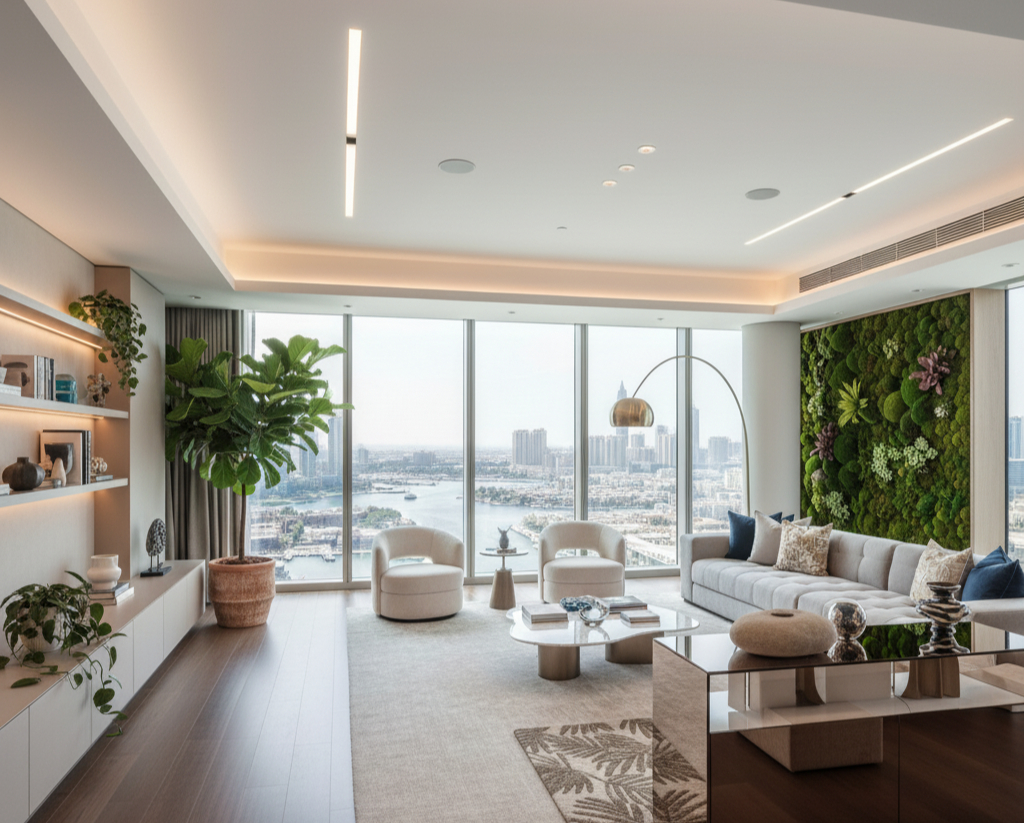
2. Living Walls and Plant-Based Interiors: More Than Just Instagram-Worthy
Yes, living walls (vertical gardens) photograph beautifully. But their real value runs far deeper than social media appeal.
These installations create miniature ecosystems within your home. They:
- Actively purify air by removing VOCs (volatile organic compounds)
- Regulate humidity levels naturally
- Provide natural sound insulation (brilliant for noisy neighbourhoods)
- Create biophilic focal points that genuinely calm the nervous system
Real-World Impact:
I recently installed a 4-metre living wall in a high-rise apartment. The homeowner, a busy executive, reported not only improved air quality (confirmed by air monitoring) but also a noticeable reduction in noise from the neighbouring unit. Plus, her children became fascinated with plant care—an unexpected bonus.
Beyond living walls, consider:
- Integrated planters: Built into architecture rather than added as afterthoughts
- Multi-storey atriums: For villas and larger homes, these create dramatic interior landscapes
- Indoor water features: From subtle bubbling fountains to elaborate koi ponds
- Biophilic art: Large-format botanical prints and nature photography
The key is choosing plants suited to Dubai’s indoor conditions. ZZ plants, snake plants, and fiddle leaf figs are nearly indestructible, whilst pothos and philodendrons offer lush, cascading greenery with minimal fuss.
3. Organic Materials: Touch, Feel, Connect
Here’s something most people don’t realise: luxury isn’t just visual. It’s deeply tactile. The materials we touch daily profoundly affect how we experience our homes.
Biophilic design in 2025 is moving decisively away from cold, synthetic surfaces towards materials that tell stories:
Trending Natural Materials:
- Reclaimed teak and oak: Aged wood with character and history
- Travertine and limestone: Dubai’s natural stone offering thermal mass benefits
- Terracotta and clay tiles: Traditional materials reimagined for modern spaces
- Natural textiles: Linen, organic cotton, wool, and jute
- Cork flooring: Sustainable, sound-dampening, and naturally antimicrobial
- Bamboo elements: Rapidly renewable and structurally impressive
A villa project in Jumeirah Golf Estates featured reclaimed teak accent walls throughout. The difference was remarkable—not just aesthetically, but in how the space felt. Warm, grounding, and authentically luxurious in a way polished marble simply couldn’t match.
Colour Palettes Inspired by Nature:
Dubai’s unique landscape offers incredible colour inspiration:
- Warm desert beiges and sandy tones
- Deep ocean blues and turquoise from the Arabian Gulf
- Soft greens from oasis vegetation
- Terracotta and clay reds from traditional architecture
- Muted greys from weathered stone
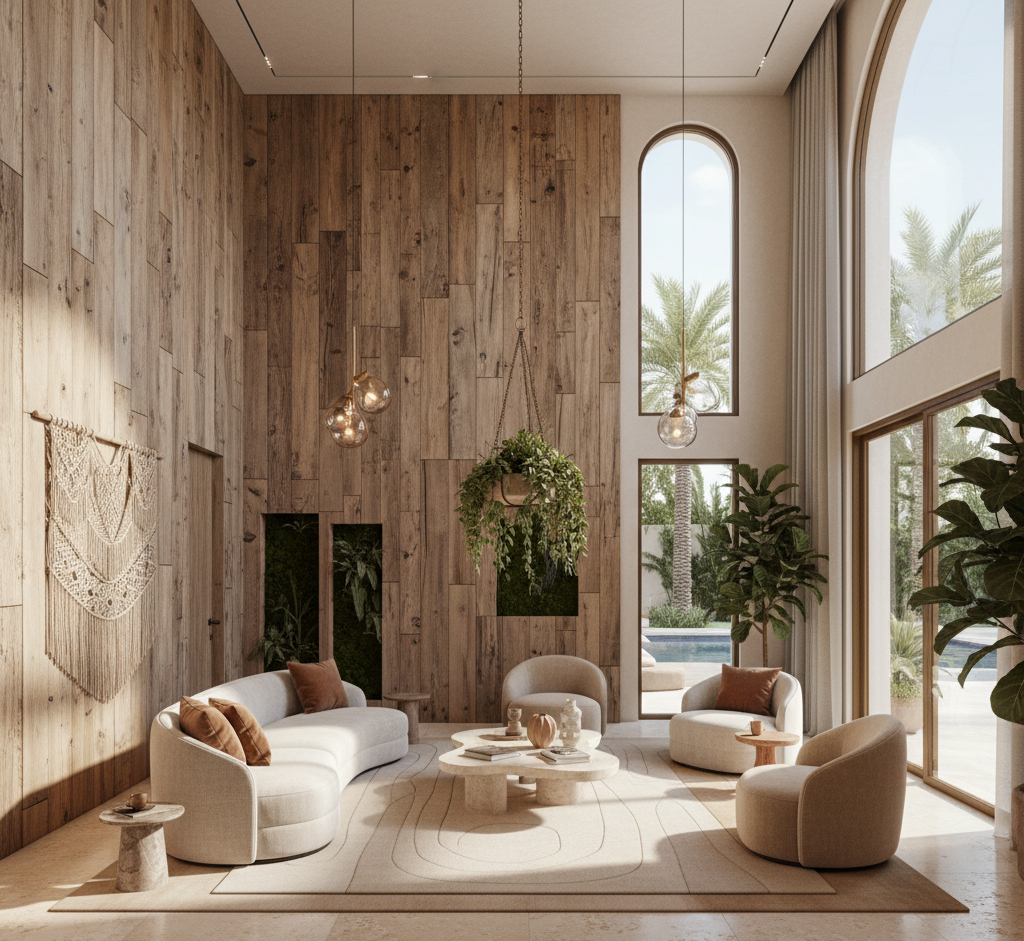
4. Biomorphic Forms: Curves Over Corners
Ever noticed how almost nothing in nature has sharp 90-degree angles? Trees curve, rivers meander, clouds billow. Our brains are literally wired to find these organic shapes more comfortable and less threatening than harsh geometric forms.
Biophilic design embraces this through:
- Curved furniture: Rounded sofas, circular coffee tables, oval dining tables
- Arched doorways and windows: Softer transitions between spaces
- Flowing staircases: Spiralling or curved designs rather than rigid straight flights
- Organic-shaped lighting: Fixtures inspired by natural forms like waves, branches, or cocoons
- Custom joinery: Wavy edges on shelving and cabinetry
This shift towards curves is particularly prominent in 2025 Dubai interiors. It’s a welcome departure from the ultra-minimalist, hard-edged aesthetic that dominated the 2010s.
5. Multi-Sensory Engagement: Design Beyond the Visual
Brilliant biophilic design engages all five senses, not just sight. This is where luxury truly elevates.
Sound:
- Gentle water features create natural white noise
- Rustling leaves from indoor trees
- Smart systems play ambient nature soundscapes
- Acoustic panels with natural textures
Scent:
- Fresh flowers are rotated weekly
- Aromatic herbs in kitchen gardens
- Essential oil systems with natural fragrances
- Natural wood scents from timber elements
Touch:
- Varied textures throughout—smooth stone, rough timber, soft textiles
- Temperature variations (cool stone floors, warm wooden surfaces)
- Tactile wall treatments
Air Quality:
- Plants as natural air purifiers
- Advanced ventilation systems
- Non-toxic, low-VOC materials throughout
- Humidity control matching natural comfort levels
Real Transformation: Downtown Penthouse Case Study
Let me share a recent project that beautifully illustrates biophilic design’s transformative power.
The Challenge: A 3,200 square foot penthouse in Downtown Dubai with spectacular views but a cold, sterile interior. The client, a finance executive, wanted a sanctuary—not just another glossy showpiece.
The Approach: We implemented a comprehensive biophilic strategy:
- Living Wall Installation: A dramatic 8-metre living wall along the main living area featuring tropical species, ferns, and trailing plants
- Natural Materials: Reclaimed oak flooring throughout, with a stunning fluted limestone feature wall
- Strategic Greenery: Large mature olive trees in custom planters, creating instant impact
- Water Feature: A subtle, wall-mounted water feature providing ambient sound
- Organic Furniture: Curved, linen-upholstered pieces with soft, flowing lines
- Optimised Lighting: Smart systems maximise natural light whilst minimising glare
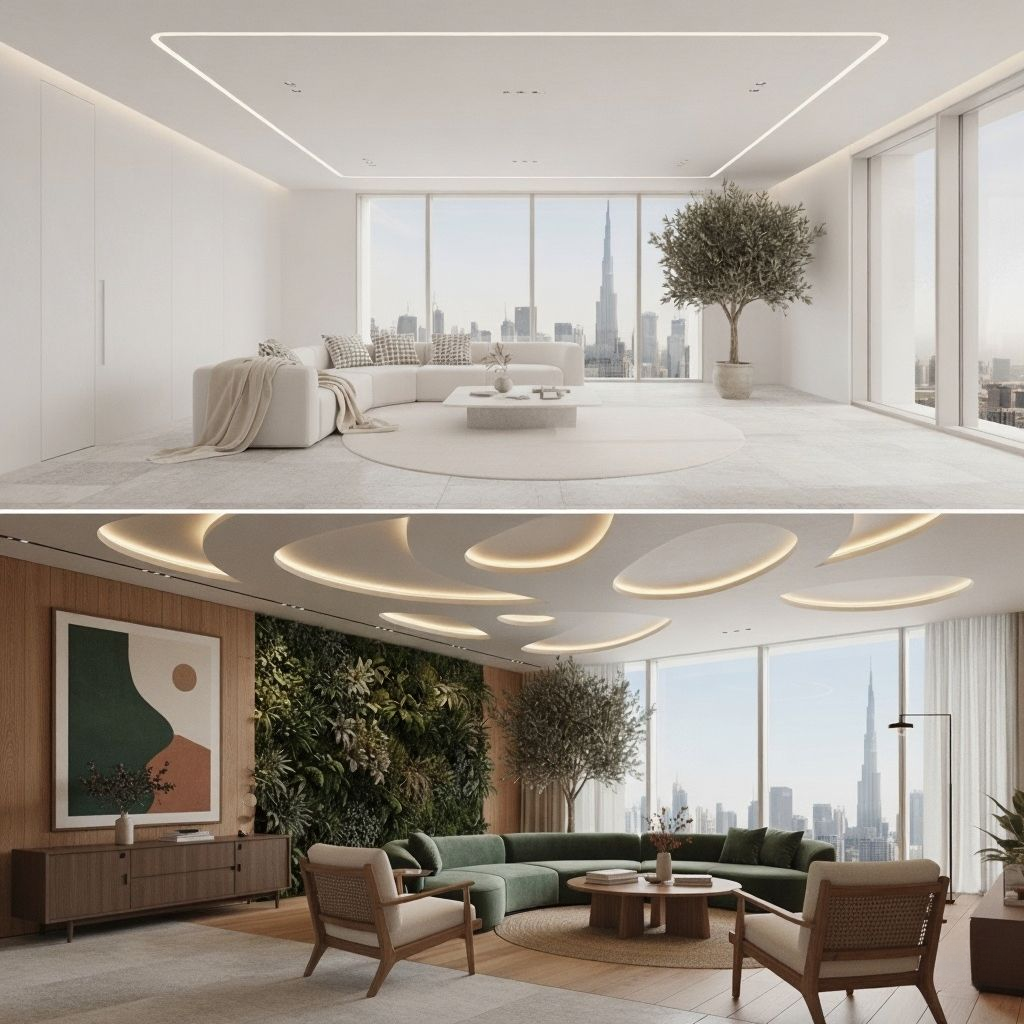
The Results: Beyond the obvious aesthetic improvement, the measurable impacts were striking:
- Air quality improved by 24% (measured via air quality monitors)
- The client reported significantly better sleep (validated by his smartwatch sleep tracking)
- Reduced stress levels—he described feeling “instantly calm” upon arriving home
- Energy costs decreased by 15% due to natural light optimisation
- The property value increased substantially due to unique design features
This wasn’t just interior design—it was wellness architecture at its finest.
Biophilic Design Trends Dominating Dubai in 2025
The biophilic movement continues evolving. Here’s what’s particularly hot right now:
1. Smart Technology Meets Nature
Automated plant care systems that monitor soil moisture, light levels, and nutrient needs. Smart lighting that mimics natural circadian rhythms. AI-powered climate control optimising comfort whilst reducing energy use. The marriage of technology and nature is becoming seamless.
2. Indoor Edible Gardens
Dubai residents are increasingly creating dedicated spaces for herbs, microgreens, and even compact vegetable gardens. There’s something profoundly satisfying about picking fresh basil from your kitchen wall for tonight’s pasta. Plus, it’s the ultimate biophilic design Dubai flex.
3. Biophilic Home Offices
With hybrid work here to stay, home offices are getting serious biophilic upgrades. Think:
- Desks positioned near windows with garden views
- Standing desks made from natural timber
- Living walls as focal points (brilliant for video calls)
- Natural light optimisation for reduced eye strain
- Acoustic plant installations for noise reduction
4. Wellness Rooms and Meditation Spaces
Dedicated biophilic sanctuaries for yoga, meditation, or simply unplugging. These spaces typically feature:
- Maximum natural light or soft, nature-inspired lighting
- Natural materials throughout
- Indoor water features
- Views of greenery
- Natural scent elements
5. Biophilic Communities
Forward-thinking developers are incorporating biophilic principles at the master-plan level. Expect to see more developments featuring:
- Extensive green corridors connecting neighbourhoods
- Community gardens and allotments
- Natural water features and native landscaping
- Pedestrian-friendly, tree-lined pathways
- Shared biophilic amenity spaces
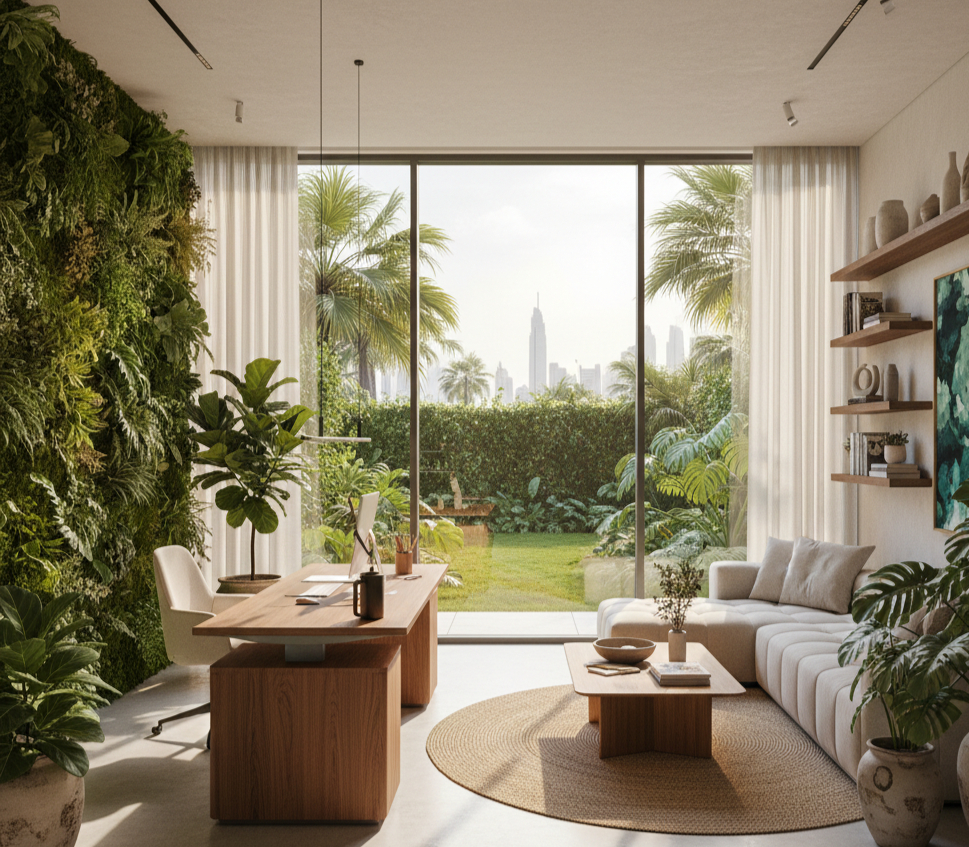
Getting Started: Practical Biophilic Design Tips for Dubai Homes
Inspired but not sure where to begin? Here’s a realistic roadmap for introducing biophilic elements into your home—regardless of budget.
Quick Wins (Under AED 5,000):
- Strategic plants: Start with 3-5 large, statement plants in high-traffic areas (living room, entrance, bedroom)
- Natural textiles: Swap synthetic cushions and throws for linen, cotton, or wool versions
- Maximise natural light: Replace heavy curtains with sheer, natural fabrics or bamboo blinds
- Nature art: Large botanical prints or nature photography
- Small water feature: Desktop or console-table fountains
Medium Investment (AED 5,000 – 20,000):
- Professional living wall: Small to medium installation in a focal area
- Natural flooring: Cork or bamboo flooring in one room
- Timber accent wall: Reclaimed or sustainable wood feature
- Natural stone elements: Bathroom vanity or kitchen splashback
- Outdoor connection: Upgrade balcony with plants, natural furniture, and soft lighting
Full Transformation (AED 20,000+):
- Comprehensive living walls: Multiple installations throughout
- Material overhaul: Natural flooring, stone surfaces, timber joinery
- Smart lighting systems: Circadian-rhythm-supporting automation
- Integrated water features: Built-in elements with professional installation
- Architectural modifications: Enlarged windows, skylights, or atriums
Dubai-Specific Considerations:
Our unique climate presents both challenges and opportunities:
- Heat management: Biophilic design must work with smart glazing and shading to prevent excessive heat gain
- Humidity control: Essential for plant health and human comfort
- Plant selection: Choose species suited to air-conditioned environments
- Maintenance planning: Professional plant care services are worthwhile investments
- Water efficiency: Use drip irrigation systems for living walls and indoor gardens
Common Biophilic Design Mistakes (And How to Avoid Them)
After years of implementing biophilic projects, I’ve seen certain pitfalls repeatedly. Here’s how to sidestep them:
Mistake #1: Too Many Plants, Too Fast
The Problem: Enthusiasm leading to plant overload without proper care planning.
The Solution: Start with 3-5 easy-care plants. Once you’ve mastered their needs, gradually expand your indoor jungle.
Mistake #2: Ignoring Light Requirements
The Problem: Placing light-loving plants in dim corners (where they’ll slowly die).
The Solution: Match plants to available light. Low-light areas? Snake plants and ZZ plants. Bright spots? Fiddle leaf figs and bird of paradise.
Mistake #3: Synthetic “Natural” Materials
The Problem: Faux wood, plastic plants, and synthetic textiles that defeat biophilic principles.
The Solution: Invest in authentic materials. They genuinely look, feel, and perform better long-term.
Mistake #4: Neglecting Maintenance
The Problem: Installing elaborate living walls or water features without maintenance plans.
The Solution: Budget for professional maintenance or choose low-maintenance alternatives. Dead plants aren’t biophilic—they’re depressing.
Mistake #5: Forgetting Functionality
The Problem: Prioritising aesthetics over livability.
The Solution: Biophilic design should enhance daily life, not complicate it. Ensure plants don’t block pathways, natural materials are practical for your lifestyle, and systems actually function reliably.
The Investment Perspective: Does Biophilic Design Add Value?
Let’s talk brass tacks. Is biophilic design worth the investment financially?
Research and market data suggest a resounding yes:
- Property value: Homes with thoughtful biophilic elements command 7-15% premiums in Dubai’s luxury market
- Rental appeal: Biophilic apartments let faster and retain tenants longer
- Energy savings: Natural light optimisation and smart systems reduce utility costs by 10-20%
- Health benefits: Fewer sick days, better mental health—financially significant over time
- Longevity: Quality natural materials age beautifully, unlike trendy finishes that date quickly
Moreover, biophilic design aligns perfectly with Dubai’s sustainability agenda and the UAE’s commitment to environmental responsibility. Properties embracing these principles are increasingly seen as forward-thinking investments rather than mere residences.
The Future of Biophilic Design in Dubai
Looking beyond 2025, where is this movement headed?
Industry experts predict several exciting developments:
- Biomimicry in architecture: Buildings that literally function like living organisms, with facades that breathe and adapt
- Mycelium materials: Mushroom-based building materials offering sustainability and unique aesthetics
- Regenerative design: Homes that actively improve their environments rather than simply minimising harm
- Biophilic artificial intelligence: AI systems that optimise natural elements based on occupant wellbeing data
- Community biophilia: Entire neighbourhoods designed around biophilic principles
Dubai’s position as a global innovation hub makes it the perfect testing ground for these emerging concepts. Expect the city to lead rather than follow in biophilic design evolution.
Your Biophilic Journey: Where to Start
Whether you’re planning a complete renovation or simply want to bring more nature into your current space, the biophilic design philosophy offers something for everyone.
The beauty lies in its scalability. You don’t need a villa in Emirates Hills to benefit. Even a studio apartment can become a restorative sanctuary with thoughtful application of biophilic principles.
Your First Steps:
- Assess your space: Note natural light patterns, existing materials, and potential plant locations
- Define your goals: Better sleep? Reduced stress? Improved air quality? Clearer objectives guide better decisions
- Start small: Pick one room to transform first—typically the bedroom or living area
- Choose quality over quantity: A few excellent natural elements beat dozens of mediocre ones
- Plan for maintenance: Ensure you can realistically care for living elements or budget for professional services
- Consult professionals: For larger projects, work with designers experienced in biophilic principles
Remember, biophilic design isn’t about perfection. It’s about reconnection—with nature, with ourselves, with what genuinely makes us feel alive and well.
Conclusion: Luxury Redefined
We’ve come a long way from the days when luxury meant maximum marble and minimum maintenance. Today’s definition is far more nuanced, more conscious, and frankly, more interesting.
Biophilic design Dubai represents this evolution perfectly. It acknowledges that true luxury isn’t just about expense—it’s about experience. It’s about creating environments that don’t just impress visitors but genuinely nurture the people who live there daily.
In a city that’s always chasing the next big thing, biophilic design offers something refreshingly timeless: a connection to the natural world that humans have craved for millennia. It’s not a trend that’ll be passé next season. It’s a fundamental shift in how we conceptualise living spaces.
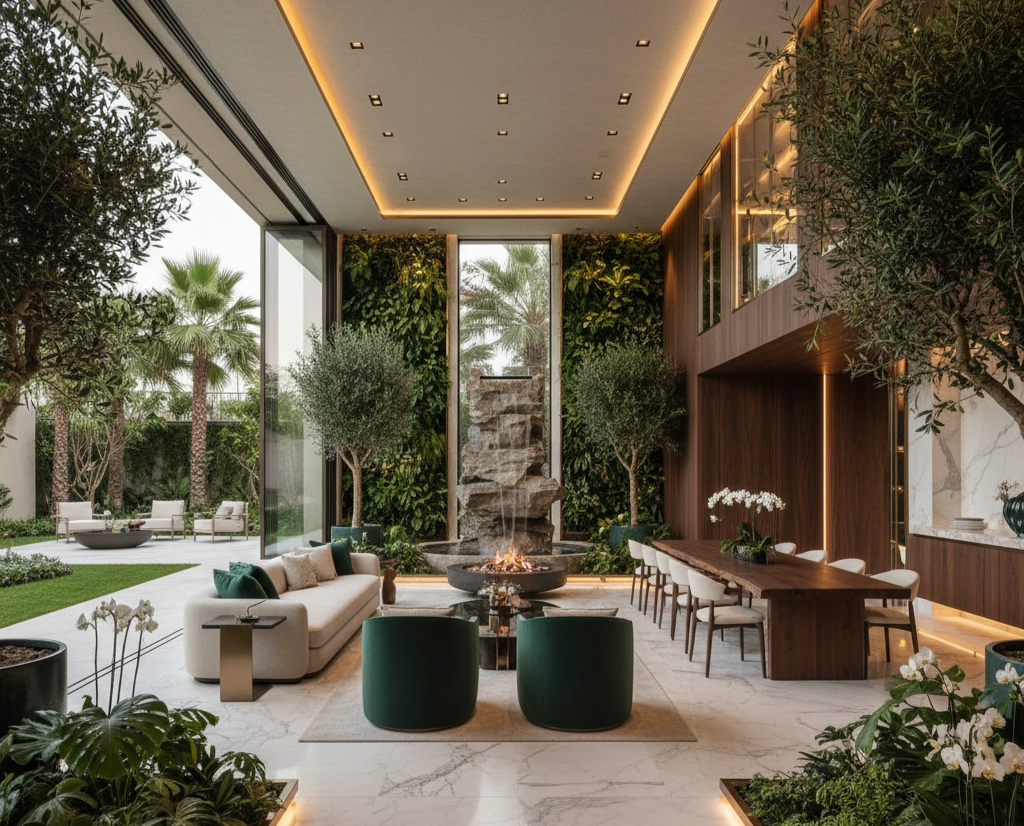
So whether you’re planning your dream home, renovating your current space, or simply curious about bringing more life into your interiors, consider the biophilic approach. Your mind, body, and spirit will thank you for it.
After all, we weren’t designed to live in concrete boxes. We were designed to thrive amongst nature. Biophilic design simply brings that possibility back—even fifty floors above the ground.
Ready to transform your Dubai home into a biophilic sanctuary?
The journey from sterile to serene begins with a single plant…
Contact us today to discuss your Dubai interior design project
Share this:
- Click to share on Facebook (Opens in new window) Facebook
- Click to share on Pinterest (Opens in new window) Pinterest
- Click to share on X (Opens in new window) X
- Click to share on LinkedIn (Opens in new window) LinkedIn
- Click to share on Reddit (Opens in new window) Reddit
- Click to email a link to a friend (Opens in new window) Email
- Click to print (Opens in new window) Print

